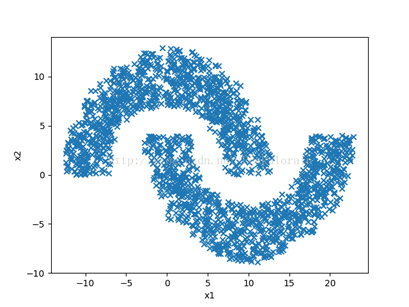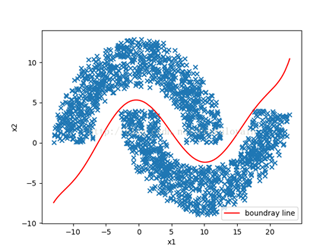TensorFlow 二分类神经网络模型 利用TensorFlow训练简单的二分类神经网络模型的方法
Mars_Alonere 人气:0想了解利用TensorFlow训练简单的二分类神经网络模型的方法的相关内容吗,Mars_Alonere在本文为您仔细讲解TensorFlow 二分类神经网络模型的相关知识和一些Code实例,欢迎阅读和指正,我们先划重点:TensorFlow,二分类神经网络,TensorFlow,神经网络,下面大家一起来学习吧。
利用TensorFlow实现《神经网络与机器学习》一书中4.7模式分类练习
具体问题是将如下图所示双月牙数据集分类。

使用到的工具:
python3.5 tensorflow1.2.1 numpy matplotlib
1.产生双月环数据集
def produceData(r,w,d,num): r1 = r-w/2 r2 = r+w/2 #上半圆 theta1 = np.random.uniform(0, np.pi ,num) X_Col1 = np.random.uniform( r1*np.cos(theta1),r2*np.cos(theta1),num)[:, np.newaxis] X_Row1 = np.random.uniform(r1*np.sin(theta1),r2*np.sin(theta1),num)[:, np.newaxis] Y_label1 = np.ones(num) #类别标签为1 #下半圆 theta2 = np.random.uniform(-np.pi, 0 ,num) X_Col2 = (np.random.uniform( r1*np.cos(theta2),r2*np.cos(theta2),num) + r)[:, np.newaxis] X_Row2 = (np.random.uniform(r1 * np.sin(theta2), r2 * np.sin(theta2), num) -d)[:,np.newaxis] Y_label2 = -np.ones(num) #类别标签为-1,注意:由于采取双曲正切函数作为激活函数,类别标签不能为0 #合并 X_Col = np.vstack((X_Col1, X_Col2)) X_Row = np.vstack((X_Row1, X_Row2)) X = np.hstack((X_Col, X_Row)) Y_label = np.hstack((Y_label1,Y_label2)) Y_label.shape = (num*2 , 1) return X,Y_label
其中r为月环半径,w为月环宽度,d为上下月环距离(与书中一致)
2.利用TensorFlow搭建神经网络模型
2.1 神经网络层添加
def add_layer(layername,inputs, in_size, out_size, activation_function=None):
# add one more layer and return the output of this layer
with tf.variable_scope(layername,reuse=None):
Weights = tf.get_variable("weights",shape=[in_size, out_size],
initializer=tf.truncated_normal_initializer(stddev=0.1))
biases = tf.get_variable("biases", shape=[1, out_size],
initializer=tf.truncated_normal_initializer(stddev=0.1))
Wx_plus_b = tf.matmul(inputs, Weights) + biases
if activation_function is None:
outputs = Wx_plus_b
else:
outputs = activation_function(Wx_plus_b)
return outputs
2.2 利用tensorflow建立神经网络模型
输入层大小:2
隐藏层大小:20
输出层大小:1
激活函数:双曲正切函数
学习率:0.1(与书中略有不同)
(具体的搭建过程可参考莫烦的视频,链接就不附上了自行搜索吧......)
###define placeholder for inputs to network
xs = tf.placeholder(tf.float32, [None, 2])
ys = tf.placeholder(tf.float32, [None, 1])
###添加隐藏层
l1 = add_layer("layer1",xs, 2, 20, activation_function=tf.tanh)
###添加输出层
prediction = add_layer("layer2",l1, 20, 1, activation_function=tf.tanh)
###MSE 均方误差
loss = tf.reduce_mean(tf.reduce_sum(tf.square(ys-prediction), reduction_indices=[1]))
###优化器选取 学习率设置 此处学习率置为0.1
train_step = tf.train.GradientDescentOptimizer(0.1).minimize(loss)
###tensorflow变量初始化,打开会话
init = tf.global_variables_initializer()#tensorflow更新后初始化所有变量不再用tf.initialize_all_variables()
sess = tf.Session()
sess.run(init)
2.3 训练模型
###训练2000次
for i in range(2000):
sess.run(train_step, feed_dict={xs: x_data, ys: y_label})
3.利用训练好的网络模型寻找分类决策边界
3.1 产生二维空间随机点
def produce_random_data(r,w,d,num): X1 = np.random.uniform(-r-w/2,2*r+w/2, num) X2 = np.random.uniform(-r - w / 2-d, r+w/2, num) X = np.vstack((X1, X2)) return X.transpose()
3.2 用训练好的模型采集决策边界附近的点
向网络输入一个二维空间随机点,计算输出值大于-0.5小于0.5即认为该点落在决策边界附近(双曲正切函数)
def collect_boundary_data(v_xs):
global prediction
X = np.empty([1,2])
X = list()
for i in range(len(v_xs)):
x_input = v_xs[i]
x_input.shape = [1,2]
y_pre = sess.run(prediction, feed_dict={xs: x_input})
if abs(y_pre - 0) < 0.5:
X.append(v_xs[i])
return np.array(X)
3.3 用numpy工具将采集到的边界附近点拟合成决策边界曲线,用matplotlib.pyplot画图
###产生空间随机数据
X_NUM = produce_random_data(10, 6, -4, 5000)
###边界数据采样
X_b = collect_boundary_data(X_NUM)
###画出数据
fig = plt.figure()
ax = fig.add_subplot(1, 1, 1)
###设置坐标轴名称
plt.xlabel('x1')
plt.ylabel('x2')
ax.scatter(x_data[:, 0], x_data[:, 1], marker='x')
###用采样的边界数据拟合边界曲线 7次曲线最佳
z1 = np.polyfit(X_b[:, 0], X_b[:, 1], 7)
p1 = np.poly1d(z1)
x = X_b[:, 0]
x.sort()
yvals = p1(x)
plt.plot(x, yvals, 'r', label='boundray line')
plt.legend(loc=4)
#plt.ion()
plt.show()
4.效果

5.附上源码Github链接
https://github.com/Peakulorain/Practices.git 里的PatternClassification.py文件
另注:分类问题还是用softmax去做吧.....我只是用这做书上的练习而已。
(初学者水平有限,有问题请指出,各位大佬轻喷)
加载全部内容